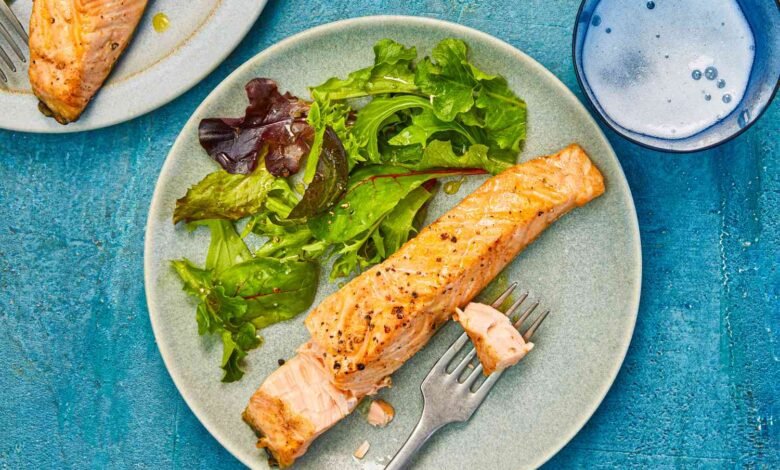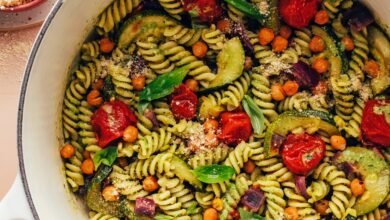

Why It Works
- Preheating the air fryer ensures that when the fish hits the basket, the hot surface will rapidly set the proteins in the fish to minimize sticking to the cooking surface.
- Select fillets that are 1 1/4 to 1 1/2- inch thick for moist well cooked fish with crisp skin.
Perfect roasted salmon should have crisp skin, and moist and tender flesh. But this can be tricky to achieve. The skin can stick to the cooking surface, the salmon can easily overcook, and the layer of fat underneath the skin can come out greasy. A simple, quick, and less messy way to get perfect roast salmon is to cook it in the air fryer.
While the device is called an air “fryer,” you’re technically still roasting when using one: Air fryers are essentially small, high-powered convection ovens. They take significantly less time to heat up and cook food, and their ability to circulate hot air quickly and evenly makes them especially handy for crisping up and roasting foods efficiently.
The enclosed cooking environment and compact structure of the air fryer also contains the mess more than if using a skillet or full-size oven. There’s no smelly fish fat splatter to clean off your stove’s backsplash or oven walls after cooking. And thanks to the air fryer’s built-in timer and controlled temperature, you don’t have to monitor the fish as closely as you would if cooking on the stovetop or in the oven.
How to Prevent the Salmon from Sticking in an Air Fryer
A major issue when cooking salmon with dry heat—whether it’s seared in a skillet or roasted in the oven or air fryer—is how the fish’s delicate flesh and skin are prone to sticking to the cooking surface. As Kenji points out in his pan-seared salmon recipe, if salmon touches a cooking surface that’s too cold, it can actually form a chemical bond with the metal, making it almost impossible to lift or flip without tearing the fish or skin. Preheating the air fryer ensures the basket is already at the proper cooking temperature, so when the fish hits the basket, the hot surface will rapidly set the proteins in the fish before there is a chance for them to start bonding with the surface.
Patting the salmon fillets dry right before seasoning and oiling them and placing them in the air fryer basket is another way to guarantee the salmon starts cooking on immediate contact with the basket. Moisture left on the surface of the fish can quickly suck away heat, so it’s important to dry your fish carefully.
If you do have a little time to spare, dry-brining the salmon at least 45 minutes in advance and letting it rest in the fridge on a wire rack set in a sheet pan uncovered for several hours can help the fish retain more moisture as it cooks while drying the surface. But if you don’t have at least 45 minutes, it’s best to season right before cooking, to prevent moisture drawn out by the salt from interfering with crisp skin.
And the final way to prevent the salmon from sticking in the air fryer basket is to create a non-stick cooking environment by rubbing the fish all over with oil and spraying the inside of the basket with cooking spray right before cooking. When spraying the basket, just make sure to do so away from direct heat of the air fryer.
How to Get Tender Flaky Air-Fryer Salmon With Crisp Skin
As mentioned earlier, the constant air flow in the air fryer does a great job at drying the exterior of foods and promoting browning, but with salmon you want to make sure the fish’s skin crisps at the same rate as the inside of the fish is cooking. If the temperature is too high, the salmon skin will start to scorch before the fish is fully cooked inside, and if the temperature is too low, the flesh will overcook before the skin has a chance to crisp. After rounds and rounds of testing, we found three key steps to guarantee salmon that has crisp skin with a perfectly cooked interior.
- Pay attention to fillet thickness: Two pieces of salmon that both weigh the exact same amount can be different thicknesses depending on the specific salmon and where on the fillet they’re cut from. This difference in thickness can directly impact the final cooking result—the thinner the fillet, the less time it will take to cook, which means the skin has less time to turn crispy. The reverse scenario is true with thicker fillets.
We tested cooking salmon fillets of five different thicknesses, starting at 3/4 inch thick and increasing in quarter inch increments all the way up to two inches thick. We found that the thinner fillets reached the proper internal cooking temperature before the skin had a chance to fully crisp, and the two-inch-thick fillet’s skin verged on burnt by the time the internal temperature reached our desired 120°F medium-rare. The “sweet spot” were fillets that were 1 1/4 to 1 1/2- inch thick. In the time it took the flesh of these fillets to reach 120°F, the skin dried out and had a pleasant crispness to it. Fillets of this thickness will come from the center cut of the salmon; try to avoid the tail end, which yields much thinner slabs of fish.
| Salmon Thickness | Cook Time for Rare (110°F) | Cook Time for Med-Rare (120°F) | Cook Time for Med (130°F) | Notes |
| 3/4 inch | 4 min | 5 min | 5 min 30 sec | The skin does not get crispy due to the short cooking time; best to remove the skin before cooking for fillets this thin. The thinner the salmon, the wider the fillet, making it more fragile and taking up more space in the air fryer |
| 1 inch | 4 min | 5 min | 6 min | The skin does not get crispy due to the short cooking time; best to remove the skin before cooking for fillets this thin. |
| 1 1/4 inch | 7 min | 8min | 9min | Skin gets nice and crispy with the help of the longer cooking time. |
| 1 1/2 inch | 7min | 8min | 9min | Skin gets nice and crispy with the help of the longer cooking time. |
While you can adjust the air fryer temperature higher or lower than our advised temp for salmon fillets that are thicker or thinner than our recommended range, we had the most consistent and highest quality result when operating with fillets that fell into this recommended thickness zone.
- Cook at 375°F: Similar to the testing scenario described above for the fillet thickness, we tested cooking temperatures with temperatures ranging from 325°F up to 400°F. Ultimately, we found the ideal cooking temperature to be 375°F. At this temperature, the fillet’s skin crisped at the same rate as the fish cooked to medium-rare.
That said, if you’re using thicker or thinner fillets than our recommended dimensions, you should adjust the cooking temperature up or down in an attempt to compensate: Lower to about 350°F if the salmon is more than 1 1/2 inch thick, and hotter to about 400°F if the salmon is less than 1 1/4 inches thick.
- Cook the fillets skin side up: For many of us, myself included, the crisp skin on a piece of roasted fish is the highlight, so this air-fryer method had to deliver on that. We tested different approaches to cooking the salmon to find the one that yielded the most crispy skin, including placing it skin side down in the hot air fryer basket (this would be the correct way if pan-searing the fish), and also skin side up.
The skin side up salmon produced much crispier skin. This is because, despite an air fryer’s ability to move air all around the cooking chamber, the main heat source comes from above since that’s where the heating element is. Plus, even with perforations in the air fryer basket, setting the skin against the basket surface when skin side down blocked air flow to the part of the fillet where we most wanted it for maximum crisping—unlike a skillet where contact with heated metal promotes crisping, contact with the fryer basket does the opposite.
How to Prevent Excessive Smoke While Cooking
If you’ve ever cooked fatty food in an air fryer before, you probably have experienced excessive smoking. This happens when the fat drips onto the heated cooking surface and heats above its smoking point. In the air fryer’s small enclosed cooking environment, that smoke builds up more quickly than it would in a larger oven. The best way to avoid this is to start with a clean air fryer. Regularly and thoroughly cleaning your air fryer avoids any unwanted grease build up that may create more smoke.
We aso minimize the risk of smoking by cooking the salmon skin side up. As mentioned earlier, this guarantees the fat layer under the skin renders into the fish’s flesh, and it doesn’t drip a much fat onto the bottom of the air fryer basket. If you’re still concerned about smoking, a couple tablespoons of water can also be added to the chamber under the the air fryer basket. The fat will then drip into the water and avoid smoking. Just be aware that added water will add moisture to the cooking environment, and may result in less crispy skin.
This Juicy Air-Fryer Salmon Makes Weeknight Dinners a Breeze
-
Two 6- to 8-ounce each (170g-227g) skin-on salmon fillets, about 1 1/4 to 1 1/2 inches thick
-
Neutral oil, such as canola, or olive oil, for rubbing salmon
-
1/2 teaspoon kosher salt; for table salt, use half as much by volume
-
1/2 teaspoon freshly ground black pepper
-
Vegetable oil spray
-
Set air fryer to 375°F and preheat for 5 minutes.
Serious Eats/Jen Causey
-
Pat salmon dry with paper towels, rub all over with oil, and sprinkle with salt and pepper.
Serious Eats/Jen Causey
-
Lightly spray the preheated air fryer basket with vegetable oil spray. Place salmon in prepared basket, skin side up. Place basket in air fryer and cook until the skin is crispy and golden at edges, and the center is still translucent when checked with tip of paring knife and the thickest portion of the fillet registers 110°F (43°C) for rare, 120°F (49°C) for medium-rare, or 130°F (54°C) for medium, 7 to 12 minutes.
Serious Eats/Jen Causey
-
Carefully transfer salmon fillets to a paper towel–lined plate and let rest for 5 minutes. Serve.
Serious Eats/Jen Causey
Special Equipment
Air fryer
| Nutrition Facts (per serving) | |
|---|---|
| 285 | Calories |
| 23g | Fat |
| 0g | Carbs |
| 19g | Protein |
Show Full Nutrition Label
×
| Nutrition Facts | |
|---|---|
| Servings: 2 | |
| Amount per serving | |
| Calories | 285 |
| % Daily Value* | |
| 23g | 29% |
| Saturated Fat 3g | 15% |
| 54mg | 18% |
| 366mg | 16% |
| 0g | 0% |
| Dietary Fiber 0g | 0% |
| Total Sugars 0g | |
| 19g | |
| Vitamin C 3mg | 16% |
| Calcium 15mg | 1% |
| Iron 0mg | 2% |
| Potassium 333mg | 7% |
| *The % Daily Value (DV) tells you how much a nutrient in a food serving contributes to a daily diet. 2,000 calories a day is used for general nutrition advice. | |
(Nutrition information is calculated using an ingredient database and should be considered an estimate.)
Source link



